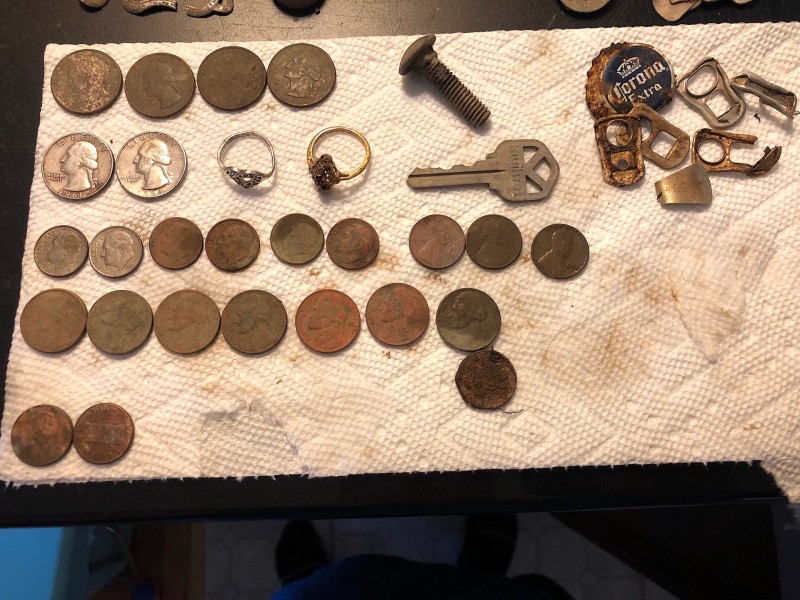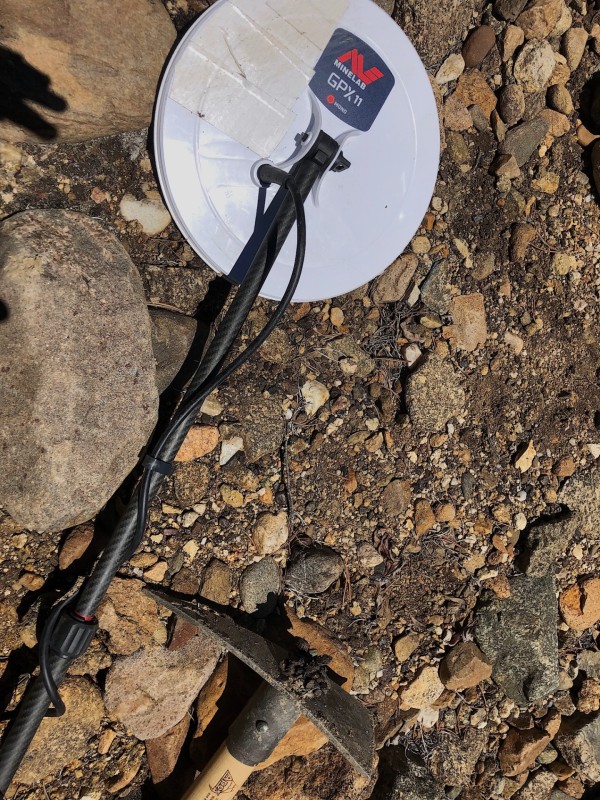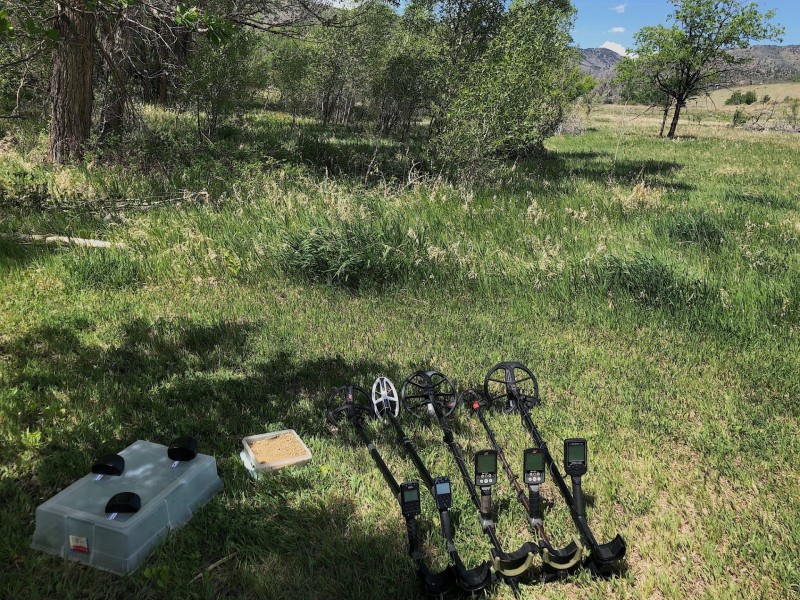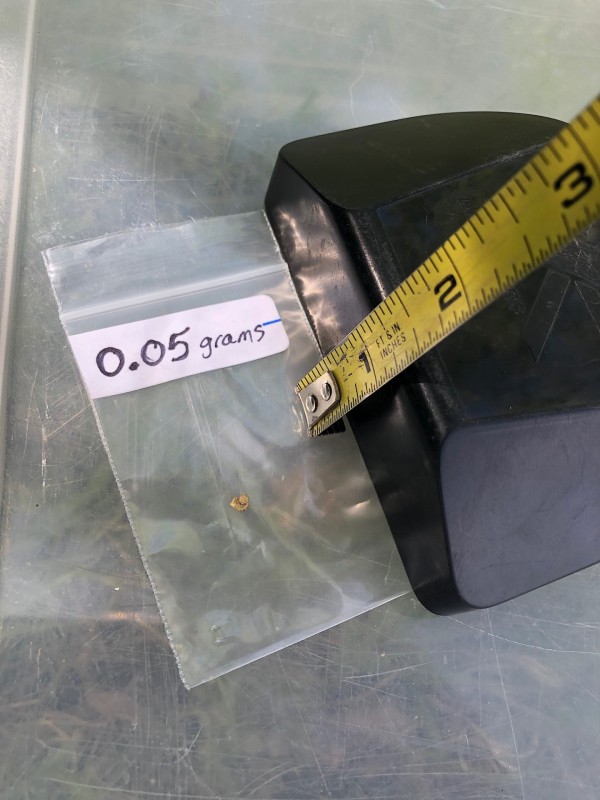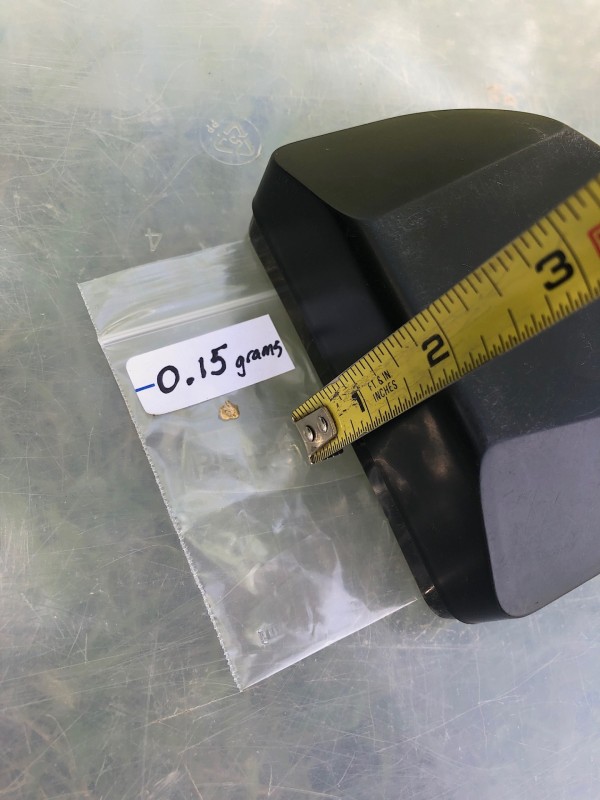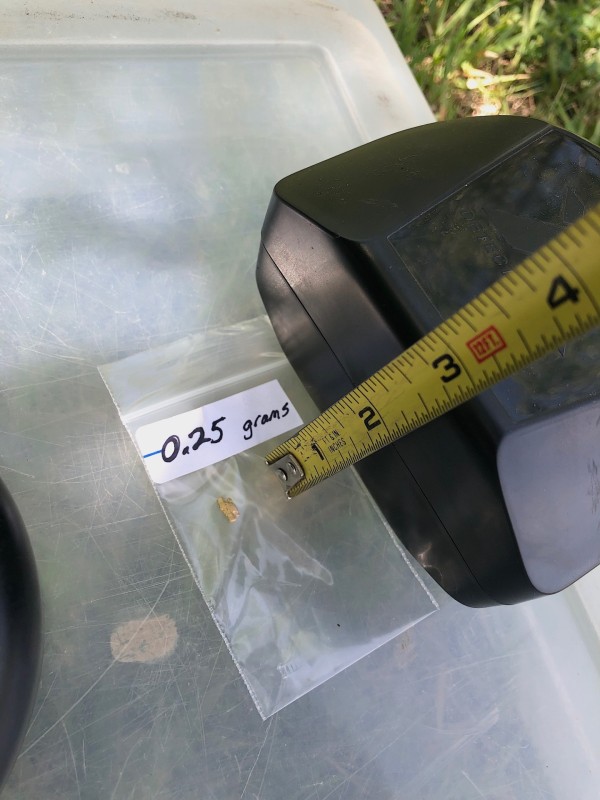-
Posts
3,191 -
Joined
-
Last visited
Content Type
Forums
Detector Prospector Home
Detector Database
Downloads
Everything posted by Jeff McClendon
-
Yep, stupid me......I totally forgot to noise cancel the Legend both times when I turned it on.....DUH. It will quieten down nicely if one follows instructions. There are huge overhead power lines about 1/4 mile to the west of that site where I did the testing. My big bad.....sorry Nokta Makro! I really enjoy using the GPX 5000 at that devil dirt site as far as adjustability and coil choices. I don't like swinging it at 11,000 feet however for very long even with a small coil and a well fitted Hip Stick.
-
This may not be practical for you, but I often will use both on the same site and literally go behind myself or hunt the same ground from a different direction using Park 1 or Park 2.
-
My Deus 1 actually does fairly well on that dirt too when it is running at 54 kHz or higher. I have found some nice specimen gold mixed with quartz with it at that site. Some of the dirt has been hydraulicked and rearranged and some is natural. Since this site is on an 11,000 foot mountain side some of the dirt horizon is tilted upward and I can literally swing my coil and pass over several cross-sections of dirt with different ground phases. Mostly with the GPX 6000 I just end up in Auto 1 (11). Also there is the pea sized to ping pong ball sized magnetite that is all over the ground and virtually every metamorphic rock is a hot/cold rock. All of that stuff is easy to recognize with the Equinox 6" coil using a wide open Gold 1 or Gold 2 and then having a modified 2 tone Field 2 in the User Profile. With the GPX 6000, those subtle differences in the soil horizons sound like good targets. So do many of the smaller pieces of magnetite and hot rocks that are under the surface....... Maybe a smaller coil will help.
-

XP Deus 2 Modern Trash First Impressions
Jeff McClendon replied to Jeff McClendon's topic in XP Deus II Forum
Right now I keep bottle cap reject on zero. That may be dumb but it has worked for me so far. I go by the tones and their characteristics and sometimes check the horseshoe graph. The dirt here is so mineralized that even good coin targets start to get iffy at about 6” depth with sporadic iron responses. When I use bottle cap reject the deeper borderline good targets get even more iffy. -

XP Deus 2 Modern Trash First Impressions
Jeff McClendon replied to Jeff McClendon's topic in XP Deus II Forum
Thank you for reading and responding. Please feel free to jump right in and offer whatever your experiences have been. I got to hunt for a short period of time today with my Deus 2 for coins and jewelry. It did not disappoint. I have hunted this area extensively with my Deus 1 recently and a little with an Equinox 600 a couple of years ago. It is a school/city park site that had new sprinklers and sidewalks put in about 4 years ago. I have found some older nickels including Buffaloes and Wheat pennies so I knew silver was a possibility. I sure didn't expect silver Washington quarters however. These two quarters and several of the other quarters were on edge in the 4 to 6" depth range. So were the other coins. I was really glad to get the silver ring also. The nickels also really get me excited since they are so easy to hear on Deus 2 by setting up a small tone bin for them. The little pile of trash in the top right of the photo are the square tabs and beaver tails that also can be found in the 60 to 64 target ID area. So can rusted/bent Corona steel crown bottle caps which are found a lot in my area. The "gold" ring is gold plated/Avon bling........too bad! The XP Deus 2, even with basic General program settings, is proving to be quite the coin and jewelry detector. -

Equinox Or Nokta Makro Legend
Jeff McClendon replied to Alberto Montano's topic in Metal Detector Advice & Comparisons
Being a former AT Pro and AT Gold owner, the Equinox 600 and the Legend are outstanding steps up. Even when compared to the AT Max they are a big step up. Not knocking the Garrett AT Series one bit here. They were state of the art 10 years ago. They just can't compete now with the great features included with the Legend and Equinox and I can assure you they will detect just as well as the AT Max. Selling the AT Max and buying even a $254 Nokta Makro Simplex, as recommended by Steve is not a joke by the way. He is serious as far as the excellence of the Simplex and so am I.- 5 replies
-
- nokta legend
- minelab equinox
-
(and 1 more)
Tagged with:
-
I just want to add two things. I was never a big fan of the X-35 Deus 1 coils for small gold prospecting and for ground balancing in bad mineralization. I found it to be a very noisy coil. The 9" FMF coil sure looks and acts a lot like the X-35. I could have run Deus 1 using the HF elliptical at 54 kHz or higher and it would have performed much better. I was just trying to keep the testing as level as possible. Also, what I am showing here has already been proven by Andy (abenson) in his Deus 2 (11")/ Deus1/Equinox/GPX 5000 nugget testing videos which are posted on this site and on his YouTube channel "Relics and Rings"
-
I agree strick. The ability of the Equinox to ground balance in that dirt is remarkable. I could have done a lot of settings adjustments (and did off camera) but I decided to at least stay with default sensitivity settings if possible. I kept Deus 1's frequency close to the other detectors 31.3 kHz and Deus 1 and Deus 2 Goldfield sensitivity at default 95.............lowering it and raising the reactivity a bit helped some but depth loss was even bigger. So I just made sure to set up the two Goldfield programs as close to the same as possible by using PWM VCO on both, adjusting audio response the same and maxing the volume. For me, the Legend did just fine. I have had my GPX 6000 at the location where that dirt came from and I usually spend hours chasing ghost/hot ground signals. I get frustrated, pull out my Equinox 800 and enjoy the hunt.......go figure. The work required to make a little video like this with just an iPhone and Youtube's video editor is ridiculous. Anyone who does this regularly should be commended. Making it also helped me make some decisions. I am just going to have to put up with Deus 2's Goldfield performance and not take it to places with dirt that bad. I have found gold with Deus 1 at that location so I just figured Deus 2 would automatically at least be the equivalent of Deus 1.
-
I have been hunting with Deus 2 exclusively for about 2 weeks and I must say, I really like it. Of course, I really like Deus 1 except for how it detects (poorly) in high mineralization on deeper than 3" coin sized targets. Deus 2 fixed that for sure. So, I gathered up a .05 gram flattish nugget and used half of an XP audio module/backphones container which is 1.25" high for a minimum height air test. Did the same with a .15 gram nugget with the other half (1.75") of the XP audio puck container and used a whole XP audio puck container (2.5") with a .25 gram nugget. I also did a surface and 1" deep buried test with the flat .15 gram nugget in a container of highly iron mineralized dirt from a hydraulic mine site in the Colorado mountains. I removed all of the bigger pieces of magnetite which filled a sandwich bag and the dirt still maxes out the mineralization bars on Deus 1 and Deus 2. Even my GPX 6000 hates this dirt. There is some wind noise and some drag racing noise from Bandimere Speedway. There is also a good deal of video of my butt....sorry. My IPhone also overheated twice so this video has a couple of splices. The Deus 2 audio sounds a bit weak during the air testing of the .05, .15 and .25 gram flat nuggets. It actually isn't weak. It is PWM VCO audio and the targets are at the edge of detection. The volume is maxed out on Deus 2. I also totally forgot to do a noise cancel on the Legend. It is a bit noisy and it is my fault. The video is kind of long.....19 minutes with no talking. Hope you can see the detector displays most of the time. Making videos is definitely not my thing but some people won't believe it until they see it. One's word used to be enough.....
-

Please Can I Have Help With Identification
Jeff McClendon replied to WarpedSiren's topic in Rocks, Minerals, Gems & Geology
It is kind of hard to do a hardness test using a polished sphere..... I am going to unequivocally say that the sphere in your photograph is not Lepidolite mica. If it was Lepidolite you should see many cleavage faces and much smaller polished individual platelets of mica. Personally, I think your Kunzite supposition is an excellent one. I do see some evidence of cleavage planes and the white/lavender color zoning is just right for less gem quality Kunzite that is tending towards more common Spodumene. It is very beautiful. The Harding Mine near Taos NM had some Spodumene crystals that were also tending towards Kunzite that were huge along with Lepidolite and other amazing lithium rich pegmatite minerals. I say had because I have not been there in 30 years. -

XP Deus 2 Modern Trash First Impressions
Jeff McClendon replied to Jeff McClendon's topic in XP Deus II Forum
That is what happened today for me too. I got mostly strong hits on 6 to 8” coins on edge. A few were like you described and were clad coins with slightly different quality hits on each side. On edge copper pennies did not respond like that. I can also hear weird audio when locating coin spills or multiple coins stuck together. I can’t describe that sound yet but it is very distinctive. -

XP Deus 2 Modern Trash First Impressions
Jeff McClendon replied to Jeff McClendon's topic in XP Deus II Forum
I have not seen Deus 2 do something that the Equinox or Legend can’t do yet. I knew there were still targets in the area I hunted since I had only gridded it in one direction. I only got my coil over four shallow targets out of the 60 that I dug today. Those 4 were recent drops according to their 2021/2022 dates. The rest of the 56 coin and trash targets I dug today were in the 4 to 8” range and could have easily been masked/poorly oriented hunting in one direction. There are so many steel crown bottle caps and pull tabs on or near the surface that accidentally moving them an inch when people are using the park, when the grass gets cut or when we have bad weather can easily unmask a deeper coin. -

XP Deus 2 Modern Trash First Impressions
Jeff McClendon replied to Jeff McClendon's topic in XP Deus II Forum
I don’t use notches unless the trash or hot rocks are just unbearable. I do use tone bins to help learn the detector. Tone bins were 0 to 10, 11 to 59, 60 to 64, 65 to 88, 88 to 99. I set my tones to pitches I like and can remember…….but I am a classically trained musician so my tone choices are very subjective. thanks for asking -
I have been out a few times during some insane weather with the new Deus 2. Finally today we had some good weather conditions and good soil moisture levels in the local parks for perfect deep target conditions. I was using the 9" coil in stock General mode. The only adjustments I made were to use Square Wave audio and to set 5 tone bins for iron, low conductor gold/aluminum, US nickels, mid conductor aluminum/zinc penny, and the last bin was for copper pennies, dimes, quarters and any silver coins or jewelry. I only dug targets with tones and IDs in the US nickel and copper penny/silver ranges. I walked over hundreds of other trash targets that were visible or heard along with what were probably zinc pennies/small shot bottle aluminum screw caps. I had hunted this park originally with Deus 1 and later gridded part of it with the Equinox. The Equinox has tallied 8 silver dimes and 27 wheat pennies at this one park. It is the kind of place where most of the good targets are 6 to 8"+ deep and are covered with a dense surface to 6" matting of can slaw, pull tabs of all sorts, and thousands of steel crown bottle caps and aluminum screw caps. I deliberately hunted mostly the area that had been gridded with the Equinox. Due to the numerous aluminum targets that crowd into the US nickel range on the Equinox (11,12,13) it has been really hard for me to hunt nickels and gold rings that respond with those numbers since I would have to dig hundreds of targets in a small area and might only move 10 feet during a 2 hour hunt. Denver Parks and Rec. would also have something to say about hundreds of dig holes in a 10'x10' area......not happening. Limiting that US nickel bin to 60 to 64 on Deus 2 cut way down on the aluminum targets that I dug today. I easily located 6 nickels (one was a 1934 Buffalo) and all were in the 6" to 8" range. They had no doubt nickel bin tones and IDs. I only dug 4 other targets in that range. 3 were detached, deep beaver tails from ring pulls and one was a thick, nickel sized piece of can slaw. Very impressive since Deus 1 for instance would up-average US nickels from 62 to the low 90s after 3" depth. It would do the same to pull tabs/can slaw........extremely annoying considering the price and reputation of the original Deus and one reason I am very glad to have a Deus 2. Detecting targets in the copper/silver bin was super easy. I did experience a little up averaging of 6" to 8" copper pennies and clad dimes but I quickly learned what Deus 2 was telling me. Those deep high conductors in the 8 to 10 mineralization bar dirt that I was hunting in had mostly good numbers. The up-averaging happened more in the Deus 2 audio which had the correct high tones but also had some sporadic iron tones mixed in. Occasionally I would see a 00, 01 to 05 pop up along with the correct 90 to 95 depending on the target. I checked each hole that had some iron responses mixed in with high conductor responses and there were no man-made iron targets present. I managed quite a few copper Memorial pennies, one Wheat, several clad dimes and two really deep late 1960s quarters. Most of these targets were on edge or at least tilted. So, Deus 2 as opposed to Deus 1, is an outstanding modern trashy park detector for sure in even moderate to high mineralization. Very impressive. Next time I will go after some of the deeper, more iffy signals. Today this park was full or city workers who were trying to deal with all of the broken limbs and damaged trees from our weekend late May snow/wind storm. I did not want to look like I was digging too deep or for too long in one spot.
-
So, I have been keeping mostly in the background and reading your responses to my first post in this topic. No one has addressed the elephant in the room which very simply is..........why was Deus 2 Fast completely missing those tiny foil targets 2 inches closer to the coil than that dime? I used the word "missing" on purpose. They were clearly present. The Equinox hit them easily. Unfortunately, after using a Deus 2 for over a week, I believe it has very little to do with target separation or some kind of "super detector which can see through aluminum foil" advanced behavior.
-

Help Me Decide, GPX 6000 Or GPZ 7000?
Jeff McClendon replied to Nickw's topic in Minelab Metal Detectors
If the area you are in has even mild to moderate EMI, you will need the 14" DD coil for the GPX 6000. If you have to resort to using the 14" DD you may still need a harness/hipstick especially in rocky, uneven, mountainous terrain. If you don't have EMI issues and can use the 11" mono with no harness, the GPX 6000 is easy to use, easy to swing and super easy to master. I have no experience with the GPZ 7000 other than swinging one for an hour a couple of years ago and deciding to move on/wait for something lighter. I am a longtime GPX 5000/4800 owner. The GPX 6000 with the 11" coil is extremely sensitive compared to the 5000. Currently, I still think the 5000 is deeper on larger gold simply because it can be used with much bigger coils. -
Here is one of dozens of Deus 2/Nox comparisons done by this YouTube content creator. As he says it is a very interesting test. I am absolutely not trying to stir up trouble here. These videos are out there for anyone to see and you interpret them anyway you want. As an often daily modern aluminum trash/steel alloy coin and jewelry hunter AND a gold prospector using both the Equinox, Deus 1 and ORX (so no bias here) I see this test from a very different angle than the conclusions drawn by the video maker. I am a subscriber to this person's channel so I am not taking a shot at anyone here. This is just a good example of a well (I think) intentioned test that can be looked at more than one way. I see it like this: 1. I don't think I have ever used Field 2 on purpose for a coin and jewelry hunt in a modern aluminum/steel trashed park. I have used Park 2 but that is only after using Park 1 extensively at the same site beforehand. 2. This video shows very clearly why Field 2 would be (and is even on the Equinox 600) an excellent small gold prospecting mode. 3. It appears that Deus 2 Fast would not be such a good gold prospecting mode. 4. Deus 2 in Fast hits that dime really well and should do very well in modern aluminum/steel trashed areas if the trash is really small........ 5. Equinox in Field 2 multi (ignore what the video maker says and look carefully at all of the target IDs not just the ones he points out) is actually hitting ALL of the targets (at least 4 different ones including the dime). 6. Park 1 and Field 1 multi have a very different result in this test…….….by the way. Just my take on this very short video. You may see it very differently
-

A Big Lump And The Funeral Of The GPX 6000
Jeff McClendon replied to phrunt's topic in Minelab Metal Detectors
I hope you will consider using the GPX 6000 with the 14" DD coil for EMI mitigation too along with your GPZ...... That would be an interesting comparison during live digs.- 34 replies
-
- minelab gpz 7000
- gold found
-
(and 1 more)
Tagged with:
-
First, I don't think there is any "pure" lead shot around since the late 1800s. Most of it is alloyed with something and in the wild can be heavily oxidized........... I have been using what is said to be #9 lead shot from an older Winchester AA 12 gauge shotgun shell. I measured and weighed 20 different pellets. All were shiny and not heavily oxidized. None were magnetic so definitely mostly lead with some alloys mixed in. All of these pellets fit inside my electronic calipers that were set to 2.03 mm. All weighed in the .85 to .75 grain range. I also have clean, shiny unoxidized #8 and #7 lead shot for testing. I just retested with my GPX 6000, just using the 14" DD coil set on manual 6, Cancel/Difficult with correct sized #7, #8 and #9 lead alloy shot. My results were very similar to those listed above. I do use the stock headphones for this test. the #7 shot was easily detected at 1.25 inches from the upper left quarter of the coil so from 9 to 12 o'clock on the DD coil with the most sensitivity being near 12 o'clock. The #8 shot was clearly detected at .75". The #9 could be faintly detected with the pellet touching the front or back of the coil near the 12 o'clock position. When I say clearly detected to faintly detected, I mean there is a clearly audible to slightly audible repeatable change in the threshold meaning I would at least give that target a boot scrape. As far as using solid copper wire for a target, instead of lead......no clue. I also find copper coated steel shot to be much easier to detect than lead alloy shot. I would not freak out if my GPX 6000 can't faintly detect #9 shot due to the environmental factors involved like oxidation, atmospherics and audible/silent EMI. If a GPX 6000 can"t detect #7 shot (1.5 grain/2.54 mm in an air test, there is definitely a problem. Again, this topic should be in the Minelab or gold prospecting section, not the Metal Detector Advice and Comparison section. Just ask Steve or Chase to move it.
-
The Simplex is a whole lot of detector for the money and is far from "simple". You didn't mention what software version and what mode you are using. For instance, the default setting All Metal Mode has a threshold tone that is continuous (unless you lower its volume level). The threshold tone will react to the ground also if one doesn't do a ground balance especially if your coil sweeps are not level. All Metal Mode instructions are on page 9 and the Threshold feature is on page 13 in case you haven't studied the manual. Otherwise..........??????
-

Legend Version 1.07 Update
Jeff McClendon replied to Jeff McClendon's topic in Nokta / Makro Legend Forum
Carolyn, I'm glad you found this forum and also got the help you needed especially from Nokta Makro. I also received a replacement Legend system control box from Nokta Makro. Thank You Nokta Makro!!! I was easily able to perform a software update with this new system box on the same computers and with the same person (me) doing the update procedure. This replacement system control box updated on the first try with all four computers using Mac and Windows platform software, even an ancient Thinkpad running Windows 7. So, the problem was an internal issue with my original system control box and not some other issue, like not being able to follow instructions. I am fairly old, slow and stupid but I can still read....... -

Legend Vdis Gold Jewelry/aluminum Trash
Jeff McClendon replied to Jeff McClendon's topic in Nokta / Makro Legend Forum
Zinc penny is 41/42 if they are in decent shape so they are not included in the Legend VDI photo. I have found two gold rings using the Equinox that were 22s so I would be careful notching at 20 and above. Don’t know about the Deus 2 yet. I never could get anyone to tell me if it up averages, down averages or just does a double zero on borderline targets so I can’t say if notching out the high end of the target ID scale would be a safe bet or not You and I both know what the Equinox tends to do in black sand/iron mineralization. So far, discounting what has been coming from a certain source…… the Legend behaves very much like the Equinox 800, including very stable target IDs. The biggest differences between them for coin/jewelry is the Legend expanded low/mid range target IDs which actually make the trash/gold overlapping issue LESS of a problem on the Legend and the extra tone (6 tones) which make it easy to set tone breaks to match US coins and most gold jewelry. -

Legend Vdis Gold Jewelry/aluminum Trash
Jeff McClendon replied to Jeff McClendon's topic in Nokta / Makro Legend Forum
It is also very hot on the entire 15 to 25 target ID range which covers almost all women's jewelry. Those target IDs so far are just shared with foil, can slaw, the occasional rusty bottle cap and the older rectangular pull tabs as far as regularly occurring targets in most trashy parks. The two gold rings I found were in that range and were unmistakable dig me now responses.


